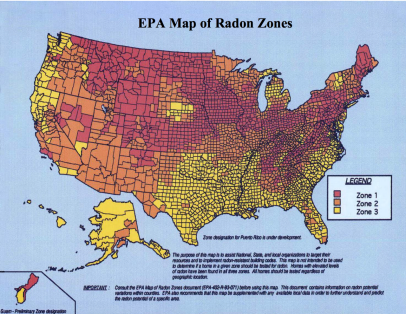What is Radon?
Radon is a naturally occurring gas that comes from the breakdown of minerals found in certain geologies. It is not because of any man-made pollution, such as landfills or illegal dumping, but rather natural occurring radon.
What does Radon do to me?
Exposure to elevated levels of radon over extended periods of time can increase the potential for lung cancer. This is why the U.S. Navy is taking steps to identify potential concerns.
Is Radon only a Problem at NSAA?
No, radon can be present in any structure that is constructed over radon producing soils or geologies. Personal residence can be of particular concern, especially with the amount of time that you and your family members spend there. That is why the U.S. EPA as well as many state agencies recommends that all homeowners and schools test for radon.
The map below was developed by the U.S. Geological Survey and the U.S. EPA, and depicts high radon potential areas across the country (shown in red). As illustrated by the map, elevated indoor radon can occur in many more areas than Bethesda. However, the area within Montgomery County is known to have a high frequency of elevated levels of radon in homes. It is highly recommended that in addition to this survey, that you test your own home. To learn more about radon and how you can test your own home, see the links at the bottom of this page.

Key Things to Remember about the Survey:
-
The devices will be attached to walls, bookcases.
-
They will be in place for one year.
-
Because radon comes from the ground, only lower portions of a selected building will be tested.
-
They pose no health risk and do not contain electronic recording instrumentation of any kind.
-
Please do not disturb the devices.
Additional Information:
To learn more about radon and how to take steps to assure a safe environment in your own home, please visit the following websites: